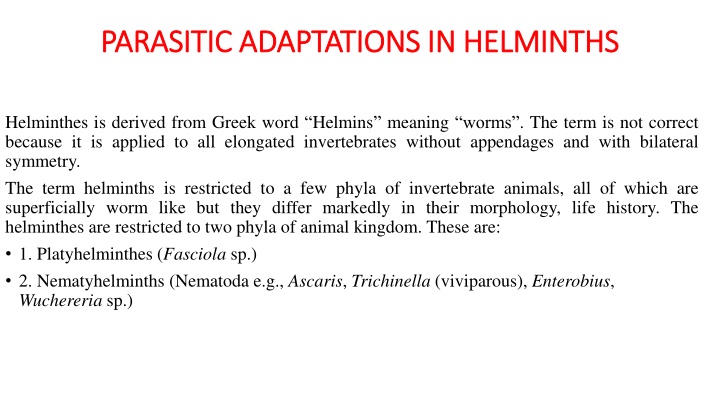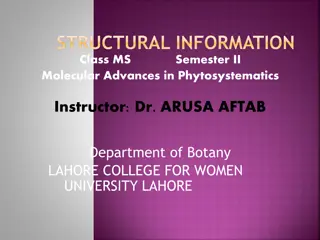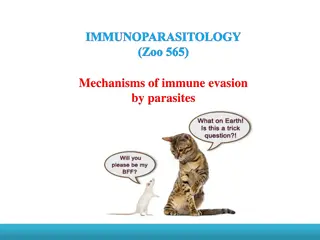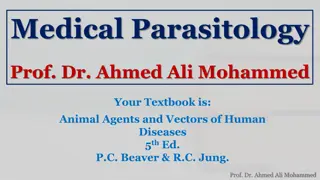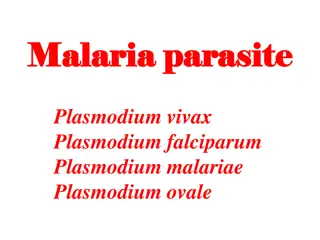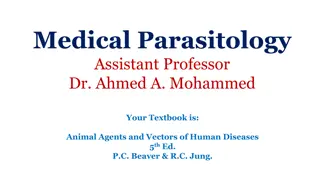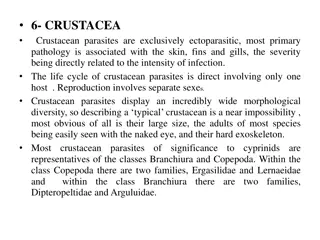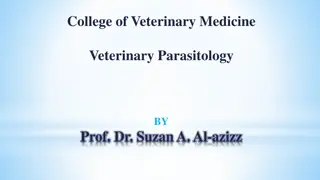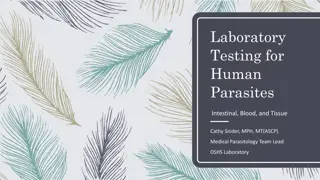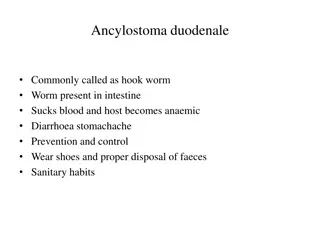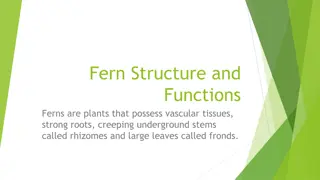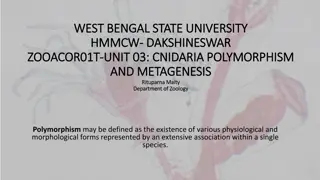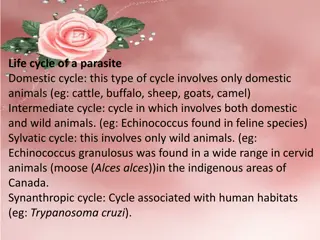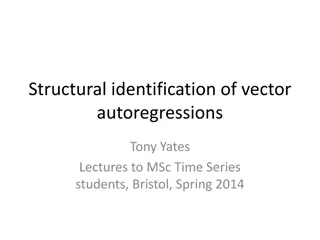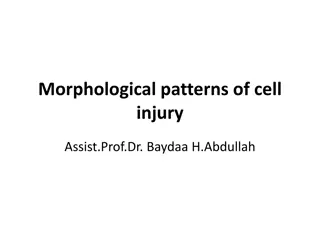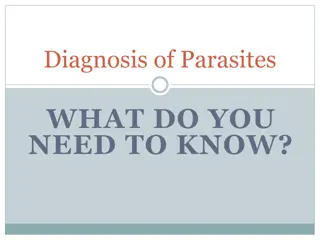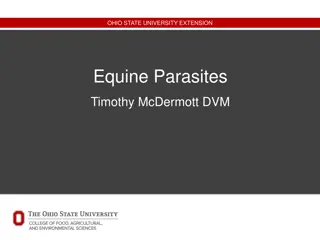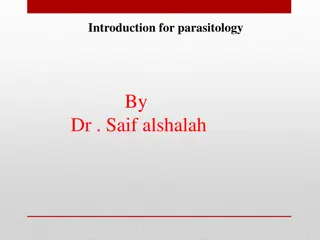Adaptations in Helminth Parasites: Structural and Morphological Changes
"Helminth parasites exhibit adaptations for successful living within hosts, involving structural modifications such as degeneration and new organ formation. Parasitism has evolved over time, leading to a dependent relationship between parasites and hosts. The adaptations in locomotory, digestive, and sensory organs enable parasites to thrive in their specific environments."
Download Presentation

Please find below an Image/Link to download the presentation.
The content on the website is provided AS IS for your information and personal use only. It may not be sold, licensed, or shared on other websites without obtaining consent from the author.If you encounter any issues during the download, it is possible that the publisher has removed the file from their server.
You are allowed to download the files provided on this website for personal or commercial use, subject to the condition that they are used lawfully. All files are the property of their respective owners.
The content on the website is provided AS IS for your information and personal use only. It may not be sold, licensed, or shared on other websites without obtaining consent from the author.
E N D
Presentation Transcript
PARASITIC ADAPTATIONS IN HELMINTHS PARASITIC ADAPTATIONS IN HELMINTHS Helminthes is derived from Greek word Helmins meaning worms . The term is not correct because it is applied to all elongated invertebrates without appendages and with bilateral symmetry. The term helminths is restricted to a few phyla of invertebrate animals, all of which are superficially worm like but they differ markedly in their morphology, life history. The helminthes are restricted to two phyla of animal kingdom. These are: 1. Platyhelminthes (Fasciola sp.) 2. Nematyhelminths (Nematoda e.g., Ascaris, Trichinella (viviparous), Enterobius, Wuchereria sp.)
The parasitic adaptation can be defined as the profound changes and modifications occurring in per-suit of successful living so that the parasite is fully adapted inside the body of the host. Cameron (1965) has stated that the parasites continue to lead their life successfully by adopting various modifications and compromises compromises in some respects parallel to those found among free-living sessile animals and those which have adopted monophagy. Two important aspects of parasitism as encountered in the hosts The structural and functional modifications in parasites depend on the degree of parasitism. In a successful parasitic group of animals the modifications run in two distinct directions one leads to loss or degeneration while the other leads to gain or new attainment.
Parasitism has begun as an accidental chance of contact between two animals and there can be no doubt that parasites may have evolved during the course of time from free living forms. Step by step changes are difficult to explain, but sooner or later the guest began to lead a more dependent life upon its host for food and shelter. This change from free-living life to one in which good shelter and nourishment are available with no efforts, has brought about profound modifications in the make up of helminth parasites. The main changes that occur in the structure and life cycle of a parasite with the help of which it is capable of leading a parasitic life successfully in its specific environment is called the Parasitic Adaptations.
MORPHOLOGICAL ADAPTATIONS MORPHOLOGICAL ADAPTATIONS Though helminths come at the bottom of organ-grade of animals, yet every part of the body of a helminth parasite exhibits twist due to parasitic mode of life. The structural modifications or adaptations of helminthes have taken place along two lines: (A) Degeneration or loss of organ/s or organ system/s. (B) Attainment of new organs.
(A) DEGENERATIONS (A) DEGENERATIONS Structures, which are partially or wholly lost. The endoparasites undergo loss or simplification of unused organs or parts. In helminths, loss or degeneration involves particularly the locomotory, digestive and the sensory organs. LOCOMOTORY ORGANS OR ORGANS OF LOCOMOTION Locomotion is actually an effort for procuring food, getting mate and escaping from enemies. But parasites habitually inhabit such places in the host s body where sufficient food is available without effort. They need not to protect themselves from enemies. Thus the organs of locomotion such as cilia of free living turbellarians [(Microstomum) freshwater], are absent in the parasitic forms [(Temnocephala) ecto on prawns]. Also free living larvae of parasites possess locomotory organs Miracidium possesses cilia & cercariae possess tail, for locomotion.
ALIMENTARY CANAL OR ORGANS OF ALIMENTARY CANAL OR ORGANS OF NUTRITION NUTRITION Since parasites consume digested or semi-digested food of the host, therefore alimentary canal and digestive glands are partially or wholly lost. In the adult trematodes there is an incomplete gut and in most of them suctorial pharynx is present, by means of which liquid food is sucked into the intestine. Intestine is always branched. In the larvae of Trematodes, the gut is either very simple (e.g., redia larva) or completely eliminated (e.g., sporocyst). In cestodes alimentary canal is altogether absent because digested food is readily available in the gut of the host.
SENSORY ORGANS SENSORY ORGANS The sense organs, necessary for quick and efficient response to the stimuli are associated with the free active life. In the host the environment is more or less uniform and so the sense organs are not essential. Hence they are reduced. In Trematodes, sense organs are absent but are generally provided with tangoreceptors (bulb like nerve endings sensitive to touch and pressure). Nematodes have reduced sense organs on the lips (Amphids) and on the tail (Phasmids). There are no sense organs in cestodes. Absence of complicated sensory structures can also be correlated to sedentary life in a sheltered habitat, especially endoparasites.
NERVOUS SYSTEM & CIRCULATORY SYSTEM NERVOUS SYSTEM & CIRCULATORY SYSTEM Living safely in more or less stable environments, paraites do not need a complex nervous system. In trematodes nervous system is developed (CNS + PNS). Nematodes possess ganglia and nerves. Cestodes possess two ganglia and a few nerves in the scolex. Circulatory system is absent because circulatory system is primarily meant for transport of nutrients that is not required in parasites.
B. ATTAINMENTS OF NEW ORGANS (SPECIALIZATIONS OR NEOFORMATIONS) Parasitic existence leads to modification of old structures and attainment of new structures helpful in food absorption, protection, attachment and vast reproduction. BODY FORM: The body form of parasites is such that they offer least resistance to the fluids of the host otherwise they might be expelled out, e.g., Fasciola is dorsoventrally flattened and leaf like. Schistosoma is thin and cylindrically elongated. Taenia is elongated like a ribbon and dorsoventrally flattened.
PROTECTIVE COVERING OR TEGUMENT/CUTICLE PROTECTIVE COVERING OR TEGUMENT/CUTICLE The outermost layer of the body was called cuticle. It is now called tegument, because of its dynamic (living) nature as it has been found out that it contains Mitochondria and E. R. It is non-cellular and rests directly on mesenchyme. It is semipermeable and allows the fluids to enter the body. The tegument becomes thin, serving partly or wholly for food absorption, in parasites living in rich nutritious environments, such as the adult liver flukes (in bile), blood flukes (in blood), tapeworms (in the intestine). Tegument protects the parasite from the harmful effects of the different types of digestive juices produced in the host. Tegument is absorptive in nature. In case of Taenia, tegument is thrown into minute projections known as microtriches which enhance the absorption by increasing the surface area. Cuticle is provided with spinules for attachment in case of Fasciola.
MUSCULATURE MUSCULATURE Musculature is well developed in helminth parasites. Muscles are meant for producing undulating movements. The well developed musculature in tapeworms (e.g., Taenia) enables them to distribute their elongated snake-like bodies throughout the lengths of the intestine of their host. Similarly, power of locomotion enables the roundworms (e.g., Ascaris) to counteract gut peristalsis and to maintain their position in the intestine. The advantage is that the worm can obtain with greater ease the pre-digested nutrients of the host.
ORGANS FOR ATTACHMENT ORGANS FOR ATTACHMENT For a firm grip on or in the host s body, some special organs of adhesion are necessary. All parasites develop suitable mechanisms for attachment with their hosts, to the exterior or to the interior of cavities. Helminths are variously modified for adhesion to the body of their hosts. Acetabula or suckers are formed in all adult parasitic flatworms.
REPRODUCTION REPRODUCTION Reproduction is well developed as the parasite lives in the hostile environment. Efficient reproductive system Hermaphroditism Multiplication of reproductive organs Large egg production Complex life cycle:
PENETRATION GLANDS/HISTOLYTIC GLANDS PENETRATION GLANDS/HISTOLYTIC GLANDS In order to penetrate into the host the parasites have developed certain structures or glands e.g., Miracidia larva has a conical process at the anterior end called apical papillae. There are a pair of penetration glands inside the body near the anterior end. These glands, called the histolytic glands secrete histolytic enzymes that help in dissolving the hosts tissue to penetrate into it. Adult worms lack these penetration glands except hookworms (Ancylostoma) which possesses these glands in the buccal region whose secretion has anticogulating and histolytic action
CYSTOGENOUS GLANDS CYSTOGENOUS GLANDS In most cercaria a large number of dark or brown cystogenous glands are found beneath the cuticle. These glands help in secreting a protective cyst around the cercaria transforming it into metacercaria. These cysts help metacercaria to overcome unfavourable conditions and protect them till they are finally eaten up by their proper host.
II. PHYSIOLOGICAL ADAPTATIONS II. PHYSIOLOGICAL ADAPTATIONS PROTECTIVE MECHANISM: Most of the parasites live within the body of hosts and hence have to protect themselves from various substances produced by the host e.g., the parasites living in the alimentary canal of the host has to protect itself from the action of the digestive juice of the host. The tapeworms accomplish this by: a) Stimulate the wall of gut to produce mucous, which then forms a protective clothing around the parasite. b) By secreting antienzymes to neutralize digestive enzymes of the host i.e., in order to protect themselves from being digested by the hosts digestive enzymes parasites produce some substances which inactivate the hosts digestive enzymes. Green in 1957 reported the presence of Trypsin and Chymotrypsin inhibitors in the body wall of Ascaris. c) Parasites continuously renew their protective body covering (i.e., tegument). Lime cells in the body wall of tapeworms neutralize the acids produced by the host. d) Parasites possess a high range of pH tolerance 4 11. e) Blood parasites are known to withstand the effects of antibodies and phagocytes by some mechanism.
NUTRITION: The nutritional requirements of the parasites are fulfilled by the host. Trematodes and Nematodes which possess an alimentary canal, though reduced, feed on both digested and semidigested food. In cestodes alimentary canal is absent, they feed on digested food only. Microtriches, tegument etc help in absorption of food. RESPIRATION OR ANAEROBIOSIS: The pH tolerance of the parasites is high from 4-11. The intestinal parasites live in an environment completely devoid of free oxygen, the respiration is of anaerobic type consisting of extracting oxygen from the food stuffs. In the absence of oxygen, energy is obtained by the fermentation of glycogen in which glucose is broken down into lactic acid. OSMOREGULATION: The osmotic pressure of body fluids of endoparasites, especially in case of Trematodes, is almost the same as that of the host so there is no necessity of osmoregulation. But in the intestinal tapeworms (cestodes) the osmotic pressure is slightly higher than that of the surrounding medium. This permits absorption of nutrients through their body wall as they lack alimentary canal. PERIODIC APPEARANCE: There are some parasites which appear at definite period. The microfilariae of W. bancrofti circulate into the peripheral blood circulation in the night between 10.00 p.m. to 4 a.m. the period when Culex bites a man (nocturnal habit) since they require Culex mosquitoes for further development. Thus their migration is correlated with the nocturnal habit of Culex
NEOTENY: It is a special phenomenon in which the larvae are capable of reproduction and they produce young ones. Ligula (Cestode) exhibits neoteny and this can be considered as an adaptation for parasitic mode of life. TRANSFERENCE OF EGGS OR INFECTIVE STAGES: This is another major problem for which the parasites have to develop adaptations. Transference from one host to another is either: (a) Active transfer: This is a less common method. The infective stages are actively transferred to final host. The larval stages of most parasites bore directly through the skin of their hosts such as the larvae of Hookworms and Schistosomes. (b) Passive transfer: This is the most common method and usually results from the careless habits of the host and is achieved in several ways such as contamination, inoculation. Oral infection occurs when the host takes uncooked food or contaminated water. The intermediate host, such as mosquitoes, inoculate parasites when they suck the blood of hosts. USE OF HOST S HORMONES: Some parasites use hormones of the host e.g., life cycles of frog and a frog trematode parasite (Polystoma integerrimum) infecting it synchronise. It has been seen that when the frog produces eggs, the parasite also produces eggs. This means that frogs secrete some hormones for producing eggs; the same hormones are used by the parasite to produce eggs.
CONCLUSION CONCLUSION The parasites are intelligent enough as are the other orgaisms which have accepted the challenge of the changing environment of host and have constantly modified / changed in order to survive in an efficient way in the hosts hostile environment. The parasites always change in such a way so as to establish an equilibrium with the host and as long as this equilibrium is maintained there are no consequence of the disease in the host but when the equilibrium is shifted the disease occurs.
